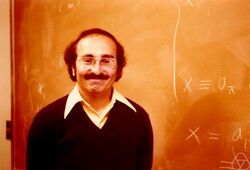Biography:Ralph Greenberg
Ralph Greenberg | |
|---|---|
 | |
| Born | 1944 (age 79–80) Chester, Pennsylvania |
| Nationality | United States |
| Alma mater | University of Pennsylvania Princeton University |
| Scientific career | |
| Fields | Mathematics |
| Institutions | University of Washington |
| Doctoral advisor | Kenkichi Iwasawa |
Ralph Greenberg (born 1944) is an American mathematician who has made contributions to number theory, in particular Iwasawa theory.
He was born in Chester, Pennsylvania[1] and studied at the University of Pennsylvania, earning a B.A. in 1966,[1] after which he attended Princeton University, earning his doctorate in 1971 under the supervision of Kenkichi Iwasawa.[2]
Greenberg's results include a proof (joint with Glenn Stevens) of the Mazur–Tate–Teitelbaum conjecture as well as a formula for the derivative of a p-adic Dirichlet L-function at [math]\displaystyle{ s=0 }[/math] (joint with Bruce Ferrero). Greenberg is also well known for his many conjectures. In his PhD thesis, he conjectured that the Iwasawa μ- and λ-invariants of the cyclotomic [math]\displaystyle{ \Z_p }[/math]-extension of a totally real field are zero, a conjecture that remains open as of September 2012. In the 1980s, he introduced the notion of a Selmer group for a p-adic Galois representation and generalized the "main conjectures" of Iwasawa and Barry Mazur to this setting. He has since generalized this setup to present Iwasawa theory as the theory of p-adic deformations of motives. He also provided an arithmetic theory of L-invariants generalizing his aforementioned work with Stevens.
Greenberg was an invited speaker in International Congress of Mathematicians 2010, Hyderabad on the topic of "Number Theory."[3]
In 2012, he became a fellow of the American Mathematical Society.[4]
In the late 1990s and early 2000s, Greenberg publicly disputed NASA conspiracy theorist and pseudoscientist Richard C. Hoagland's mathematical interpretations of the so-called "D&M Pyramid" and surrounding features found on the Cydonia Planitia region of Mars as being conclusive signs of extraterrestrial intelligence and challenged him to a public debate. Hoagland has yet to respond.[5]
References
- ↑ 1.0 1.1 "The Institute for Advanced Studies, Annual Report 1981/82". Institute for Advanced Study. https://library.ias.edu/files/pdfs/ar/annualreportforf1982inst.pdf.
- ↑ "Curriculum Vita". http://www.math.washington.edu/~greenber/vita.html.
- ↑ "ICM Plenary and Invited Speakers since 1897". International Congress of Mathematicians. http://www.mathunion.org/db/ICM/Speakers/SortedByCongress.php.
- ↑ "List of Fellows of the American Mathematical Society". https://www.ams.org/profession/fellows-list.
- ↑ "Letter to Richard Hoagland". https://sites.math.washington.edu/~greenber/update.html.
External links
 |

